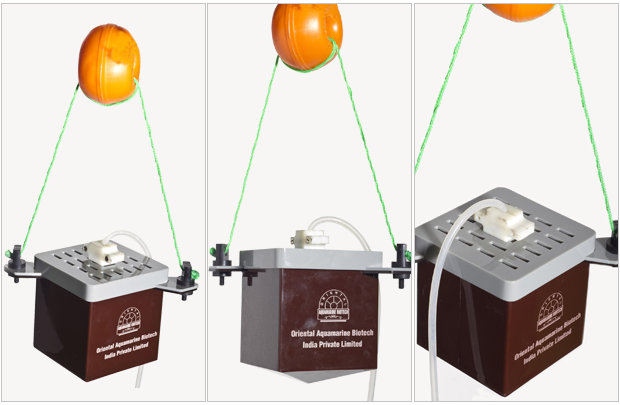In-Situ Stringed Bed Suspended Bioreactor (SBSBR)
The reactor has four components such as
- The outer fiberglass shell with conical bottom.
- Inner cartridge comprising Perspex framework and plastic beads on string.
- Airlift pump, and
- Black lid at top with perforations.

On suspending the reactor one foot below the water level on a float, and operating the airlift pump, water enters the reactor through the perforations on top of the black lid, passes through the cartridge and flows out. When water comes in contact with the immobilized bacteria on the surface of the beads, nitrification takes place and dissolved ammonia in the water is converted to nitrates and subsequently into elemental nitrogen and oxygen. The framework of the inner cartridge is made in such a way that larvae, plankton, and food particles when enters, pass out through the airlift pump without mutilation and damage.Stringed Bed Suspended Bioreactor contains 1001 beads with a surface area > 684cm2.
Biological Specifications
| Water Salinity Range | 0, 15, & 30 ppt (+/- 5 ppt) Three different cultures are available for the above mentioned salinity levels |
| Temperature | Tropical conditions-needs no heating and chilling Cold condition - needs heating and chilling |
| Total surface area of media | 684cm² |
| Purification capacity | 500 litres/day |
| TAN removal rate | 0.88gTAN/ m²/Day |
| TNN removal rate | 0.84g TNN/ m²/Day |
| Level of Dissolved Oxygen | 5.8 – 6.0 ppm |
| Nitrate level | < 8ppm |
| Backwash | Gentle rinsing once a day |
| Durability | Continuous recirculation keeps the system viable with sufficient aeration and ammonia loading |
Technical Specifications
- Acrylic outer shell &Top cover with I – bolts and locknuts
- Cartridge placed inside outer acrylic shell with gravitational airlift tube arrangement.
- Bio-media – Beads with micro perforations. Beads are stringed on inner cartridge
- Conical shaped bottom used for solid waste collection.
- Plastic float with string. Helps the reactor float in water.

